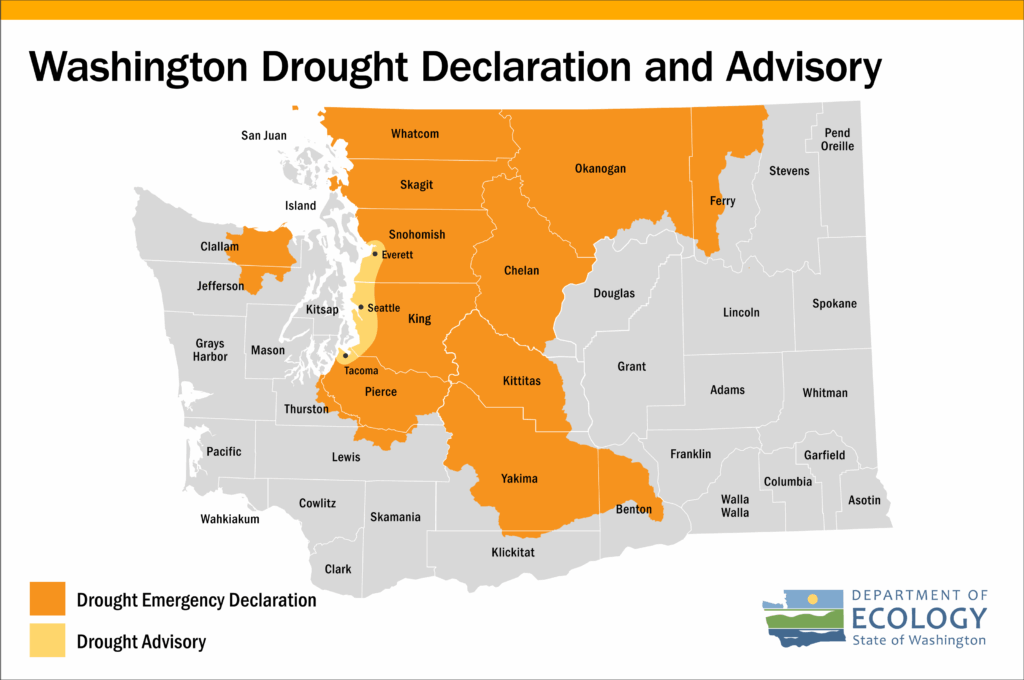Community Environment
Drought declaration covers much of Western Washington — but not Gig Harbor
Water levels remain normal across the Kitsap Peninsula even as many other parts of Western Washington experience droughts after a dry spring.
The state Department of Ecology declared a drought emergency in April to cover Yakima, then expanded it this month to include large swaths of the Puget Sound. The declaration includes most of King and Pierce counties outside of Seattle and Tacoma, along with areas on the Olympic Peninsula in Clallam and Jefferson County.
The Kitsap Peninsula, including Kitsap County and Gig Harbor, were not labeled as being in a drought. A drought declaration means these areas have 75% or less of their typical water supply and the shortage poses a risk for people or the environment, including things like agriculture or salmon runs.

Department of Ecology map shows areas under a drought declaration.
Low snowpack
Depleted snowpack levels are largely driving the water shortages, Jimmy Norris, a spokesperson for the Washington Department of Ecology, wrote in an email. During a normal year, mountain snow accumulated over the winter gradually melts throughout the spring and summer. That feeds water systems during the driest month of the year.
A particularly warm and dry spring caused the snowpack to melt faster and earlier than normal, said Caroline Mellor, Ecology’s statewide drought lead. Snowpacks in some basins melted as much as a month earlier than normal. Conditions are expected to get warmer and dryer through the summer, likely exacerbating the situation.
“The frequency of snowpack droughts in Washington is increasing — so we also need to continue planning for our long-term water supply needs,” Mellor said in a statement. “Even in Western Washington, snowpack droughts are becoming the new normal.”
Snowpack levels have been inconsistent in recent years. Scientists predict they will become even more unreliable as temperatures rise due to climate change. The state estimates snowpack drought to occur 40% of the time by 2050, according to the Department of Ecology.
Reduced snowpacks will have impacts across the state, particularly in communities at the base of the Cascade Mountains, where water systems are heavily dominated by snowmelt.
Rainwater and groundwater
Communities on the Kitsap Peninsula remain largely unaffected by these fluctuations. Unlike many of its neighbors, the peninsula gets its water almost exclusively through precipitation and groundwater aquifers.
Excluding Bremerton, all of Kitsap County is reliant entirely on groundwater, said Joel Purdy, a water resources manager for the Kitsap Public Utility District. The same is true in Gig Harbor, said Jeff Langhelm, the city’s public works director.
“Kitsap is rain-dominated in terms of its watershed,” said Karin Bumbaco, Washington’s deputy state climatologist and a researcher at the University of Washington’s Climate Impacts Groups. “It doesn’t rely on snowmelt and isn’t really sensitive to how our mountain snow is from year to year.”
That doesn’t mean the peninsula is fully insulated from droughts. It could still see low water supplies during particularly dry years. But being a rain-based watershed should protect it from some of the effects of climate change, Bumbaco said. As temperatures rise, the state is projected to see less snow, but also more rain.
“That’s good news for areas that are in rain dominated watersheds,” she said. “There wouldn’t be as much of an impact as with the lack of snow packs.”

